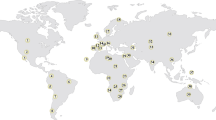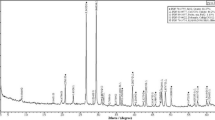Abstract
Altarpieces and polychrome carved wood from the fifteenth century AD usually exhibit golden and silvery areas by the application of a very thin foil of metal. The metal foils were normally protected from the atmosphere by a varnish or resin which maybe either preserved or absent. Moreover, they were glued to the background surface by adhesive substances (egg yolk, drying oil or animal glue). The high proportion of the glueing substances often renders the development of reaction compounds. With time, silver alters blacken or simply disappear completely. In this paper, we study the alterations to metal foils from a selection of fifteenth century artworks showing different glueing agents, organic coatings and several degrees of conservation of the organic coatings and metal leafs. The submillimetric layered structure and the high variability and low amount of most of the compounds present in the different layers, as well as their differing nature (organic and inorganic) make the use of micron-sensitive high-resolution techniques essential for their study. In particular, the high resolution, high brilliance and small footprint renders synchrotron radiation most adequate for their study. SR-XRD was performed to identify the reaction compounds formed in the different layers; μFTIR was used at to identify the silver protecting organic coatings, the metal foil glueing layers and the corresponding reaction compounds. The results obtained suggest that atmospheric corrosion is the dominant mechanism, and therefore that the degree of corrosion of the metal foils is mainly related to the conservation state of the protecting coatings.

Sampling point, MO image from surface of the sample and SEM image from polish cross-section of the sample








Similar content being viewed by others
References
Thompson DV (1956) The materials of medieval painting. Dover, New York
Brunello F (1997) Cennino Cennini, Il Libro dell’Arte, Neri Pozza (ed) Vicenza
Franey JP, Kammlott GW, Graedel TE (1985) The corrosion of silver by atmospheric sulfurous gases. Corros Sci 25:133–143
Graedel TE, Franey JP, Gualtieri GJ, Kammlott GW, Malm DL (1985) On the mechanism of silver and copper sulfidation by atmospheric H2S and COS. Corros Sci 25:1163–1180
Graedel TE (1992) Corrosion mechanism for silver exposed to the atmosphere. J Electrochem Soc 139:1963–1970
Leygraf C, Graedel TE (2000) Atmospheric corrosion. Electrochemical society series. Pennington, New Jersey
Águas RJC, Silva M, Viegas L, Pereira MR (2008) Study of environmental degradation of silver surface. Phys Stat Sol c 5:1215–1218
Ingo GM, Balbi S, de Caro T, Fragalà I, Angelini E, Bultrini G (2006) Combined use of SEM-EDS, OM and XRD for the characterization of corrosion products grown on silver roman coins. Appl Phys A 83:493–497
Bozzini B, Giovannelli G, Mele C, Brunella F, Goidanich S, Pedeferri P (2006) An investigation into the corrosion of Ag coins from the Greek colonies of Southern Italy. Part I: an in situ FT-IR and ERS investigation of the behaviour of Ag in contact with aqueous solutions containing 4-cyanopyridine. Corros Sci 48:193–208
Wanhill RJH (2003) Brittle archaeological silver: a fracture mechanisms and mechanics assessment. Archaeometry 45:625–636
Reiche I, Radtke M, Berger A, Görner W, Ketelsen T, Merchel S, Riederer J, Riesemeier H, Roth M (2004) Spatially resolved synchrotron X-ray fluorescence analysis of metal point drawings and their mysterious inscriptions. Spectrochim Acta B 59:1657–1662
Reiche I, Berger A, Görner W, Merchel S, Radtke M, Riederer J, Riesemeier H, Roth M (2004) Following the traces of Abrecht Dürer: analysis of silverpoint drawings by spatially resolved synchrotron-induced X-ray fluorescence analyses. Nucl Instrum Meth Phys Res B 226:83–91
Greagh D (2007) Synchrotron Radiation and its Use in Art, Archaeometry, and Cultural Heritage Studies in: D. Bradley, D. Creagh (ed) Physical techniques in the study of art archaeology and cultural heritage, Elsevier 2:1–95
Salvadó N, Butí S, Tobin MJ, Pantos E, Prag NWJ, Pradell T (2005) Advantages of the use of SR-FTIR microspectroscopy: applications to cultural heritage. Anal Chem 77(11):3444–3451
Cotte M, Dumas P, Taniguchi Y, Checroun E, Walter P, Jean Susini J (2009) Recent applications and current trends in Cultural Heritage Science using synchrotron-based Fourier transform infrared micro-spectroscopy. C R Phys 10:590–600
Salvadó N, Butí S, Nicholson J, Emerich H, Labrador A, Pradell T (2009) Identification of reaction compounds in micrometric layers from gothic paintings using combined SR-XRD and SR-FTIR. Talanta 79:419–428
http:/www.mnac.cat/, 2010
Ruiz I, Quesada F (2005) Pasqual Ortoneda i els retaules de Cabassers, la Secuita i Santa Margarida in: Enciclopèdia catalana (ed) L’art gòtic a Catalunya. Pintura II: El corrent internacional. Barcelona 160–161
Yu YD, Guan R, Hashimoto H, Marita Y (1995) Electron-microscope study of the structure of Ag8S formed in the initial stage of silver sulfidation. Acta Cryst B51:149–155
Guan R, Yu YD (1990) A TEM study of Ag8S formed in the early stage sulfidization of silver. Scr Metall Mater 24:869–872
Lubarda VA (2003) On the effective lattice parameter of binary alloys. Mech Mater 35:53–68
Ankersmit HA, Tennent NH, Watta SF (2005) Hydrogen sulfide and carbonyl sulfide in the museum environment-Part 1. Atmos Environ 29:695–707
Acknowledgments
This work was funded by SM2410 project (beamline B22) at Diamond Light Source, EC-69 (beamline BM01, Swiss/Norwegian CRG) and 16-01-733 (beamline BM16, Spanish CRG) projects at ESRF. Part of this work was carried out within the framework of agreements of collaboration between the Technical University of Catalonia (UPC) and the “Museu Nacional d’Art de Catalunya” (MNAC) and the “Centre de Restauració de Béns Mobles de Catalunya” (CRBMC). We wish to thank the TdArt restorers and Vinseum Museum for their collaboration in the study and for the access given to sampling of the paintings. Received financial support under “Ministerio de Ciencia e Innovación” (Spain) Grant HAR2009-10790
Author information
Authors and Affiliations
Corresponding author
Additional information
This paper was published in the special issue Analytical Chemistry for Cultural Heritage with Guest Editors Rocco Mazzeo, Silvia Prati and Aldo Roda.
Rights and permissions
About this article
Cite this article
Salvadó, N., Butí, S., Labrador, A. et al. SR-XRD and SR-FTIR study of the alteration of silver foils in medieval paintings. Anal Bioanal Chem 399, 3041–3052 (2011). https://doi.org/10.1007/s00216-010-4365-5
Received:
Revised:
Accepted:
Published:
Issue Date:
DOI: https://doi.org/10.1007/s00216-010-4365-5




